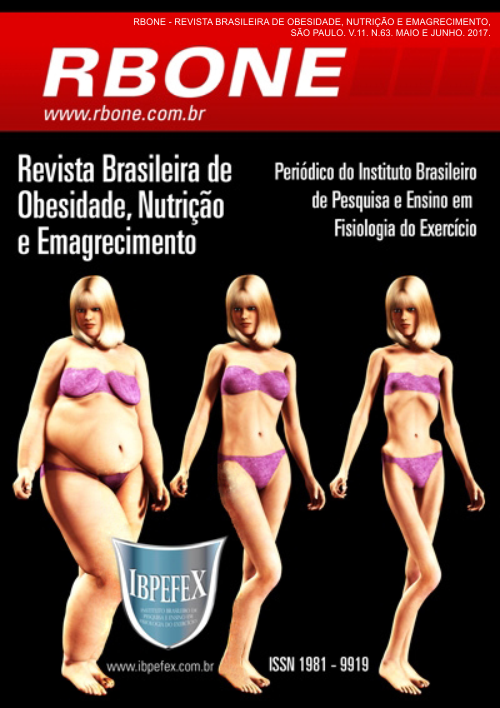Systematization of the offering of a diet for inducing obesity in adult rats
Abstract
Aim: To systematize the offering of foods which were highly palatable and rich in calories and to investigate the effects on morphometric and metabolic parameters of adult Wistar rats. Methods: The study used 15 male Wistar rats, aged 45 days old, divided into a control group and a cafeteria diet group. To the control group was offered a commercial diet ad libitum, while to the cafeteria diet group was offered the commercial diet supplemented each day with four items selected from a list of 28 foods. The consumption of foods from the cafeteria diet was checked daily, and the two groups' consumption of water and feed was checked weekly. After seven weeks, the morphometric parameters were checked and animals were sacrificed for collection of blood and the deposit of perigonadal fat. Results: The mean weight of the cafeteria diet group was higher than that of the control group, as was abdominal circumference, deposit of perigonadal fat, body mass index and the Lee index. Furthermore, animals from the cafeteria diet group presented high blood levels of triglycerides; also, changes were not observed in levels of cholesterol and glucose. Animals from the cafeteria diet group ingested more calories, carbohydrates and fats than animals in the control group. Conclusion: This study showed that a protocol of offering a cafeteria diet formulated based in foods typically consumed by the Brazilian population can be used for inducing obesity in rats, requiring a relatively short time period for obtaining results.
References
-Animal Research Review Panel. Guidelines for the Housing of Rats in Scientific Institutions -housing-rats-scientific-institutions, 2002. Available from: <http://www.animalethics.org.au/data/assets/pdf_file/0014/222512/housing-rats-scientific-institutions.pdf>. Accessed september 10, 2014.
-Bayol, S. A.; Simbi, B. H.; Fowkes R. C.; Stickland, N. C. A maternal "junk food" diet in pregnancy and lactation promotes nonalcoholic fatty liver disease in rat offspring. Endocrinology. Vol. 151. p. 1451-1461. 2010.
-Berthoud, H.R.; Lenard, N.R.; Shin, A.C. Food reward, hyperphagia, and obesity. Am J PhysiolRegul Integr Comp Physiol. Vol. 300. p. r1266-r1277. 2011.
-Brasil. Ministério da Saúde, Secretaria de Vigilância em Saúde. Vigitel Brasil 2013: vigilância de fatores de risco e proteção para doenças crônicas por inquérito telefônico. Ministério da Saúde, Secretaria de Vigilância em Saúde. Brasília. Ministério da Saúde. 2014.
-Brondel, L.; Romer, M.; Van Wymelbeke, V.; Walla, P.; Jiang, T.; Deecke, L. Sensory-specific satiety with simple foods in humans: no influence of BMI? Int J Obes (Lond). Vol. 31. p. 987-995. 2007.
-Centers for Disease Control and Prevention (CDC). Vital signs: state-specific obesity prevalence among adults-United States, 2009. MMWR Morb Mortal Wkly Rep. Vol. 59. p. 951-955. 2010.
-DeMoraes, C.; Camargo, E. A.; Antunes, E.; DeNucci, G.; Zanesco, A. Reactivity of mesenteric and aortic rings from trained rats fed with high caloric diet. Comp Biochem Physiol AMol Integr Physiol. Vol. 147. p. 788-792. 2007.
-Gonçalez, P.O. Efeitos da ração autoclavada sobre os aspectos quantitativos e morfométricos dos neurônios mioentéricos do jejuno de ratos em períodos de pré e pós-desmame. Doctoral thesis. São Paulo. Faculdade de Medicina Veterinária e Zootecnia. USP. 2004.
-Naderali, E. K.; Brown, M. J.; Pickavance, L. C.; Wilding, J. P.; Doyle, P. J.; Williams, G. Dietary obesity in the rat induces endothelial dysfunction without causing insulin resistance: a possible role for triacylglycerols. Clin Sci (Lond). Vol. 101. p. 499-506. 2001.
-Nielsen, S. J.; Popkin, B. M. Patterns and trends in food portion sizes,1977-1998. JAMA. Vol. 289. p. 450-453. 2003.
-Novelli, E. L.; Diniz, Y. S.; Galhardi, C.M.; Ebaid, G. M.; Rodrigues, H. G.; Mani, F. Anthropometrical parameters and markers of obesity in rats. Lab Anim. Vol. 41. p. 111-119. 2007.
-Pini, R. T. B. Efeitos da obesidade sobre comportamentos de ansiedade, depressão, aprendizagem e memóriaem Ratos (Rattus Norvegicus). Master’s thesis. Ribeirão Preto: Faculdade de Filosofia, Ciências e Letras de Ribeirão Preto. USP. 2012.
-Rogers, P. J.; Blundell, J. E. Meal patterns and food selection during the development of obesity in rats fed a cafeteria diet. Neurosci Biobehav Rev. Vol. 8. p. 441-453. 1984.
-Rolls, B. J.; Van Duijvenvoorde, P. M.; Rowe, E. A. Variety in the diet enhances intake in a meal and contributes to the development of obesity in the rat. Physiol Behav. Vol. 31. p. 21-27. 1983.
-Rosini,T. C.; Silva, A. S. R.; De Moraes, C. Obesidade induzida por consumo de dieta: modelo em roedores para o estudo dos distúrbios relacionados com a obesidade. Rev Assoc Med Bras. Vol. 58. p. 383-387. 2012.
-Shafat, A.; Murra, B.; Rumsey, D. Energy density in cafeteria diet induced hyperphagia in the rat. Appetite. Vol. 52. p. 34-38. 2009.
-Tschop, M.; Heiman, M. L. Overview of rodent models for obesity research. Curr Protoc Neurosci. Chapter 9. Unit 9.10. 2002.
-Zandstra, E. H.; El-Deredy, W. Effects of energy conditioning on food preferences and choice. Appetite. Vol. 57. p. 45-49. 2011.
-Zandstra, E. H.; Stubenitsky, K.; DE Graaf, C.; Mela, D. J. Effects of learned flavour cues on short-term regulation of food intake in a realistic setting. Physiol Behav. Vol. 75. p. 83-90. 2002.
Authors who publish in this journal agree to the following terms:
- Authors retain the copyright and grant the journal the right of first publication, with work simultaneously licensed under the Creative Commons Attribution License BY-NC which allows the sharing of the work with acknowledgment of the authorship of the work and initial publication in this journal.
- Authors are authorized to enter into additional contracts separately for non-exclusive distribution of the version of the work published in this journal (eg, publishing in institutional repository or book chapter), with acknowledgment of authorship and initial publication in this journal.
- Authors are allowed and encouraged to post and distribute their work online (eg, in institutional repositories or on their personal page) at any point before or during the editorial process, as this can bring about productive change as well as increase impact and impact. citation of published work (See The Effect of Free Access).






